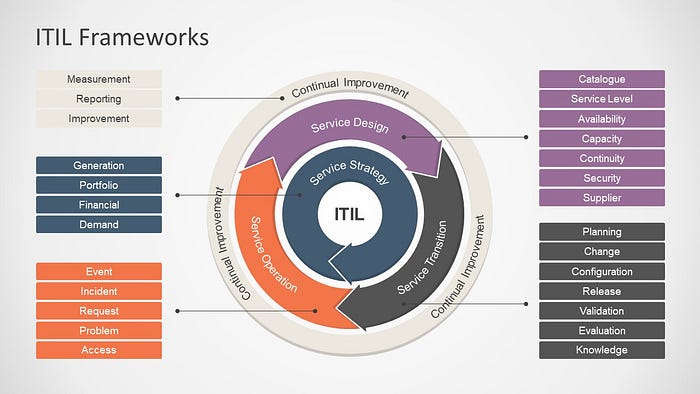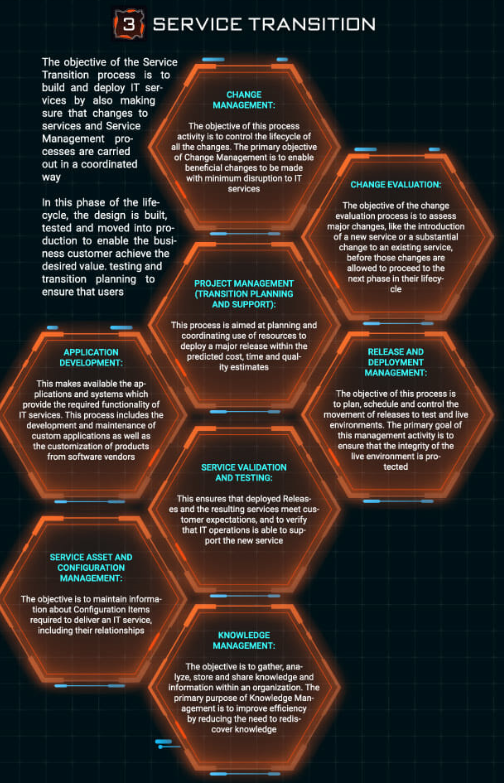Overview of ITIL
What is ITIL?
The Information Technology Infrastructure Library, better known as ITIL, is the pre-eminent framework for managing IT service delivery around the world. It defines a service lifecycle model for delivering IT services by prescribing specific processes and activities during the design, development, delivery, and support of IT services to maximize efficiency and maintain predictable levels of service. In Simple terms, IT services are any IT activities that deliver business value to a company’s end users, customers and other internal or external stakeholders.
The latest iteration of the framework is ITIL 4. Launched in 2019, ITIL 4 has evolved from the previous version by re-shaping much of the established ITSM practices in the wider context of customer experience, value streams and digital transformation, as well as embracing new ways of working, such as Lean, Agile, and DevOps.
By adopting the ITIL framework, companies ensure that their services are delivered according to a set of consistent, well-defined processes that incorporate best practices and processes, resulting in a predictable level of service for users.

Who uses ITIL?
Large, medium, and small organizations all over the world use ITIL to help them improve the value of their services. ITIL helps organizations in all industries and sectors solve business issues as well as improving IT capability. Organizations use ITIL as a guide to improve or implement a capability that provides business value.
Concepts of ITIL
- Deliver the maximum value to customers without requiring them to own unpredicted costs & risks
- Deliver the maximum service value to customers.
- Optimize the use of ‘resources’ & ‘capabilities’
- Services should offer the best utility and trustworthy warranty.
- All the processes should be planned for the specific objectives.
- Roles should be defined clearly for the task-oriented collective efforts.
Core components of ITIL
ITIL concepts are built over five core components with inherent supporting principles:
Service Strategy
The purpose of Service Strategy is to provide a strategy for the service lifecycle. The strategy should be in sync with business objectives. This phase focuses on defining services as strategic assets, and then maintaining and implementing a coherent, deliberate strategy. Service strategy principles address business processes, corporate governance and compliance, policies, corporate culture and decision-making, and ensure that the business is geared for service improvement.
As mentioned above, each major category has subcategories. Within the category of Service Strategy, there are four subcategories.

Service Design
Service design is the stage in the lifecycle that turns a service strategy into a plan for delivering the business objectives. ITIL service design deals with the issues of capacity management, continuity management, supplier management, service catalog management etc. This phase includes the assessment of business management processes to design and develop new service offerings or improve existing offerings.
ITIL Service Design provides guidance for the design and development of services and service management practices. It covers design principles and methods for converting strategic objectives into portfolios of services and service assets.
There are seven processes included in Service Design.

Service Transition
The objective of the Service Transition process is to build and deploy IT services, making sure that changes to services and Service Management processes are carried out in a coordinated way.
In this phase of the lifecycle, the design is built, tested and moved into production to enable the business customer to achieve the desired value. This phase addresses managing changes: controlling the assets and configuration items associated with the new and changed systems, service validation, testing and transition planning to ensure that users, support personnel and the production environment have been prepared for the release to production. There are seven processes within the category of Service Transition.

Service Operations
This stage focuses on meeting end-users’ expectations while balancing costs and discovering any potential problems. The Service Operations process includes fulfilling user requests, resolving service failures, fixing problems and carrying out routine operational tasks. This is the only category of the five that has functions as well as processes. There are five processes and four functions.

Continual Service Improvement (CSI)
The objective of this stage is to use methods from quality management to learn from past successes and failures. It aims to continually improve the effectiveness and efficiency of IT processes and services in line with the concept of continual improvement adopted in ISO 2000. There is only one process in this area, and it has seven steps:

What Are The Benefits Of ITIL Implementation?
The growing demand of ITIL professionals all across the world proves that the IT industries are experiencing the tremendous benefits of ITIL framework. The following 6 benefits of ITIL are experienced by the majority of IT services providers:
- Faster and more flexible service delivery practices to support digital transformation
- Better strategic alignment between IT and the business
- Smoother integration between evolving software delivery practices and the enterprise customer support framework
- Improved service delivery and customer satisfaction
- Reduced costs through improved use of resources
- Greater visibility of IT costs and assets
- Better management of business risk and service disruption or failure
ITIL became a commonly used framework providing best practice guidelines on all aspects of end to end service management. It covers complete spectrum of people, processes, products and use of partners. Now a day’s ITIL is being practiced by almost every company providing IT services to the customers.
Today, it has become a de facto standard for providing IT services. ITIL is the most widely accepted approach to IT service management in the world. Organizations use its proven best practices to run their business from strategy to daily reality.
References: bmc.com, knowedgehut.com, Simplilearn.com
